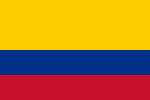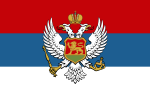-
Flag of the First Austrian Republic and present-day Austria
-
State flag and Naval ensign of Austria
-
The flag of Germany
-
The flag of East Germany, defaced with a national emblem
-
Flag of Free France, defaced with a red Cross of Lorraine
-
The flag of Hungary
-
Flag of Communist Hungary defaced with the "Rákosi coat of arms", 1949–1956
-
Flag of Communist Hungary defaced with the "Kádár coat of arms", 1957–1990
-
The flag of Serbia
-
The flag of Serbia, defaced with a Coat of arms
-
The flag of Ukraine
-
The flag of Zakarpattia Oblast, defaced with a Coat of arms
-
The flag of Vietnam
-
Flag of the Vietnam People's Public Security (Police), defaced with the force's Vietnamese motto on the top corner
-
Flag of the Vietnam People's Army (VPA), also similarly defaced with the force's Vietnamese motto on the top corner
-
Flag of the Vietnam People's Air Force, being VPA flag further defaced with the service's Vietnamese name below the star
In vexillology, defacement is the addition of a symbol or charge to a flag.[1][2][3] For example, the Australian flag is the British Blue Ensign defaced with a Southern Cross in the fly.
In the context of vexillology, the word "deface" carries no negative connotations, in contrast to general usage. It simply indicates a differentiation of the flag from that of another owner by addition of elements. For example, many state flags are formed by defacing the national flag with a coat of arms.
History
[edit]Where countries pass through changes of regime with contrasting ideological orientations (monarchist/republican, fascist/democratic, communist/capitalist, secular/religious etc.) – all of which, despite their differences, claim allegiance to a common national heritage expressed in a venerated national flag – it can happen that a new regime defaces that flag with its own specific emblem while keeping the basic flag design unchanged. Such changing ideological emblems appeared over time, among others, on the flags of Italy, Hungary, Romania, Germany (West and East; see illustration), Ethiopia, and Iran.[citation needed] For example, during the Hungarian Revolution of 1956 and the Romanian Revolution of 1989, insurgents tore the emblem of the regime that they opposed out of the national flag and waved the flag with which they identified.[4][5]
An already defaced flag can be further defaced. For example, the Australian flag is a defaced British Blue Ensign. The Australian Border Force Flag is further defaced with the words "Australian border force" in block letters.[citation needed]
In the United States, it is against the Flag Code to deface the national flag with advertising or with any other sigil, image, or insignia.[6] Such flags are nevertheless commercially available, depicting the seals of various branches of the U.S. military, Native American-related objects such as tomahawks or war bonnets, and the like.[citation needed]
It is common for association football supporters travelling abroad for a match to bring a national flag defaced with the name of their hometown or a similar local identifier.[citation needed]
Gallery
[edit]References
[edit]- ^ Smith, Whitney (1975). Flags: Through the Ages and Around the World. New York: McGraw Hill. p. 14. ISBN 0-07-059093-1.
DEFACE: To add a BADGE to an existing flag
- ^ "Deface". Dictionary of Vexillology. Flags of the World.
- ^ "Deface". Illustrated Dictionary of Vexillological Terms. North American Vexillological Association. Archived from the original on March 1, 2012.
- ^ "Hungary - 1956 Uprising Flags".
- ^ "Hungary - Romania - 1989 Revolutionary Flag".
- ^ "4 U.S. Code § 8(d)".




























